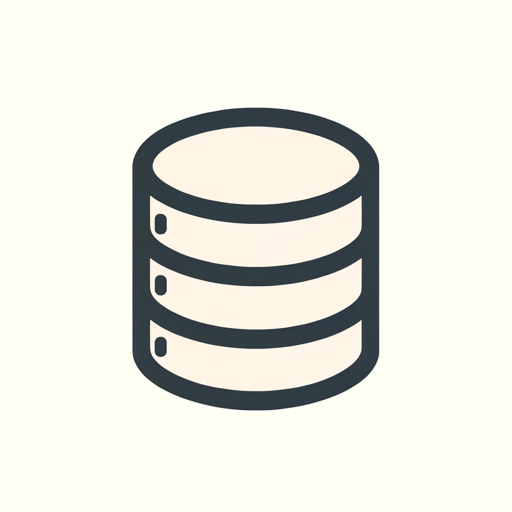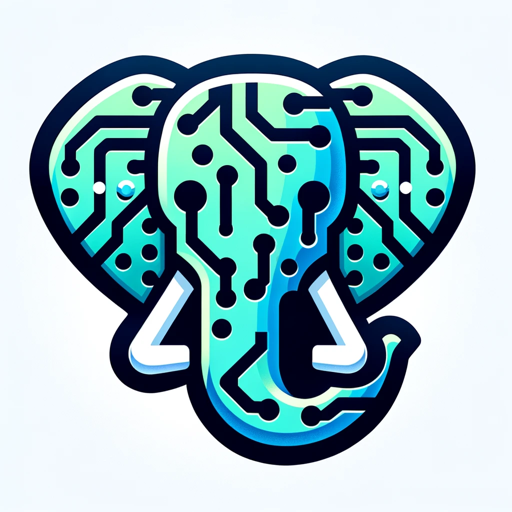PostgreSQL & DBeaver Guide-PostgreSQL & DBeaver expert advice
AI-powered assistance for PostgreSQL & DBeaver.
Help with creating a PostgreSQL database
Simplifying SQL concepts for beginners
Solving DBeaver connection issues
Optimization techniques for PostgreSQL databases
Related Tools
Load MorePostgres Expert
The GPT does act as an PostgreSQL Dataase Exrpert, It masters the knowledge of Postgres very well.

Supabase Expert
Expert in Supabase, PostgreSQL, and TypeScript for app development.

PostgreSQL (Postgres)
Advanced PostgreSQL expert, trained with the latest knowledge about Postgres database and clients

PostgreSQL Assistant
Expert in PostgreSQL data modeling and querying.

PostgreSQL Support Engineer
PostgreSQL expert focusing on technical support and troubleshooting, with restricted access

POSTGRES GPT
Expert in SQL queries and PostgreSQL, adept at navigating complex database structures and optimizing data management.
20.0 / 5 (200 votes)
Introduction to PostgreSQL & DBeaver Guide
PostgreSQL & DBeaver Guide is designed to serve as a comprehensive assistant for users working with PostgreSQL databases and the DBeaver database management tool. The guide is tailored to provide detailed, context-specific advice on database design, query optimization, and troubleshooting, ensuring that both novice and experienced users can benefit from its insights. By offering clear and concise explanations, as well as practical examples, it helps users effectively navigate the complexities of PostgreSQL and DBeaver. Whether you're setting up your first database, optimizing complex queries, or debugging issues, the PostgreSQL & DBeaver Guide acts as a friendly expert, always ready to assist.

Main Functions of PostgreSQL & DBeaver Guide
Database Design Guidance
Example
Helping a user design a normalized schema for a new e-commerce platform, including setting up tables for products, customers, and orders.
Scenario
A developer is creating a new application and needs to design a PostgreSQL database from scratch. The guide assists in structuring the database to ensure scalability and efficiency, offering advice on normalization, relationships, and indexing strategies.
Query Optimization Advice
Example
Analyzing a slow-running query in a large dataset and providing suggestions for optimization, such as using proper indexes or rewriting the query.
Scenario
An analyst is working with a large dataset and notices that certain queries are taking too long to execute. The guide helps identify the bottlenecks and suggests optimizations, such as adding indexes or modifying the query structure, to improve performance.
Troubleshooting and Debugging
Example
Assisting in resolving an issue where a user is facing errors when trying to join multiple tables in a query.
Scenario
A user is encountering unexpected errors when performing complex operations in PostgreSQL, such as multi-table joins or transaction handling. The guide helps diagnose the issue, explaining potential causes and offering step-by-step solutions.
Ideal Users of PostgreSQL & DBeaver Guide
Database Administrators (DBAs)
DBAs benefit from the guide's in-depth coverage of PostgreSQL features and best practices, helping them maintain and optimize databases effectively. The guide offers valuable insights into performance tuning, backup strategies, and security management.
Developers and Data Analysts
Developers and data analysts who need to interact with PostgreSQL databases can leverage the guide to improve their query writing skills, understand advanced SQL concepts, and integrate PostgreSQL with their applications. It’s particularly useful for those who are new to database management or looking to deepen their understanding of PostgreSQL and DBeaver.

How to Use PostgreSQL & DBeaver Guide
Visit aichatonline.org for a free trial without login, no need for ChatGPT Plus.
Start by navigating to the website to access PostgreSQL & DBeaver Guide. This platform allows you to use the guide without the need for logging in or subscribing to any premium service.
Prepare your PostgreSQL environment.
Ensure you have PostgreSQL installed on your system, along with DBeaver if you plan to use it. This will allow you to follow along with examples and execute commands directly in your database environment.
Explore use cases and common queries.
Familiarize yourself with typical use cases, such as database design, query optimization, and troubleshooting, to better understand how the guide can assist you. Consider the specific tasks you need help with, and refer to relevant sections in the guide.
Interact with the guide for personalized advice.
Use the guide to ask specific questions about PostgreSQL and DBeaver. Whether you're designing a database, writing complex queries, or troubleshooting issues, the guide can provide tailored advice and best practices.
Apply and test the solutions in your database.
After receiving guidance, implement the suggestions in your PostgreSQL environment. Test out the solutions provided to ensure they work as expected, and don't hesitate to ask follow-up questions if needed.
Try other advanced and practical GPTs
The Infinite God Body
Unlock Your Divine Potential with AI

🛠️ CMake Mastery for C++ Projects
AI-powered CMake mastery for C++ projects

Generic Website Development Template - Karan
AI-powered website creation made easy.

Snazzy Looking Copy
Enhance Your Text with AI-Powered Formatting

Novel and Short story Editor
Elevate your writing with AI precision.

Plumbing and Heating Assistant
AI-powered Plumbing and Heating Guidance

Quotes
AI-powered inspiration at your fingertips.

Upwork Responder
AI-Powered Responses for Upwork Invitations

Otter.ai Transcript Summarizer (ai guy)
AI-powered transcript summarization for key insights.

Academic Email Editor
AI-powered academic email proofreading.

Maya Guru
Optimize Maya with AI-Powered Insights

Regression Pro
AI-Powered Regression Analysis Made Easy

- Data Analysis
- Troubleshooting
- Query Optimization
- Database Design
- SQL Learning
PostgreSQL & DBeaver Guide - Common Q&A
What can I use PostgreSQL & DBeaver Guide for?
This guide is designed to assist with a wide range of tasks in PostgreSQL and DBeaver, including database design, query optimization, data analysis, and troubleshooting. Whether you're a beginner or an advanced user, it provides clear, actionable advice tailored to your specific needs.
Do I need to log in or pay to use the guide?
No, you can access the guide for free without logging in or needing a subscription. Simply visit the website to start using the guide immediately.
How does the guide assist with query optimization?
The guide provides detailed explanations and strategies for optimizing SQL queries in PostgreSQL. It covers indexing, query planning, execution analysis, and offers tips on writing efficient SQL code to improve database performance.
Can the guide help with troubleshooting errors in PostgreSQL?
Yes, the guide is equipped to help you diagnose and fix common errors in PostgreSQL. It offers step-by-step troubleshooting advice and best practices for resolving issues like connection problems, performance bottlenecks, and data inconsistencies.
Is the guide suitable for someone new to PostgreSQL?
Absolutely. The guide is designed to be user-friendly and approachable for beginners. It explains concepts in a clear and simple manner, making it easier for new users to learn and apply PostgreSQL effectively.